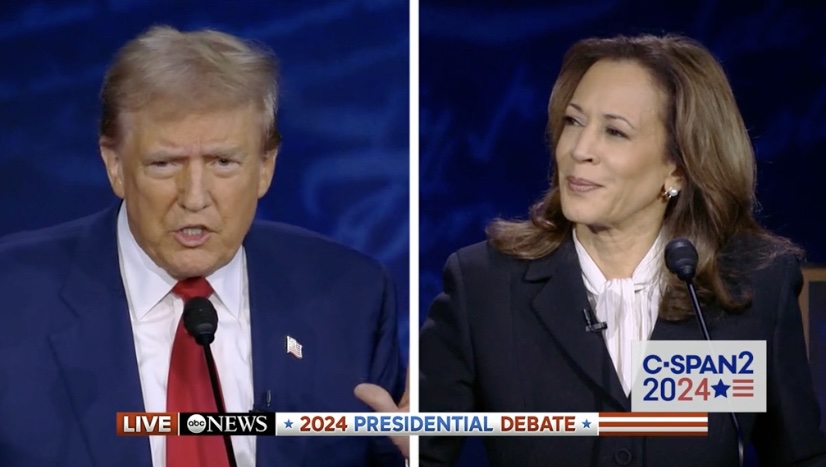Editor’s note: This post discusses Selzer’s September 2024 poll of likely Iowa voters. Her final pre-election survey, which the Des Moines Register published on November 2, showed Harris leading Trump by 47 percent to 44 percent. Original post follows.
Dan Guild is a lawyer and project manager who lives in New Hampshire. In addition to writing for Bleeding Heartland, he has written for CNN and Sabato’s Crystal Ball, most recently here. He also contributed to the Washington Post’s 2020 primary simulations. Follow him on Twitter @dcg1114.
Ann Selzer’s gold standard poll is out, and suggests a remade presidential race in Iowa.
The top line numbers from Selzer & Co’s latest poll for the Des Moines Register and Mediacom indicate former President Donald Trump has 47 percent support and Vice President Kamala Harris 43 percent among likely Iowa voters. This poll started contacting respondents on September 8 (before the debate) and concluded on September 11, the day after the debate. At the end of this piece is a summary of post-debate national polling, which has found a gain for Harris of about 1 percent.
When you compare the new survey to Selzer’s numbers from June (Trump 50 percent, President Joe Biden 32 percent in Iowa), you will find a 14 point shift in margin. But purely focusing on the margin may be a mistake.
Trump’s level of support has varied little since February, when Selzer found him ahead of Biden by 48 percent to 33 percent in Iowa. The change is in the Democratic number. Harris has consolidated the Democratic base, and the 43 percent she receives in this survey is close to the 44.9 percent vote share for Biden in the 2020 election. Selzer noted in Brianne Pfannenstiel’s write-up of the latest poll, “The race has tightened significantly.”
Two other things though are worth noting here. Robert F. Kennedy, Jr. has ended his presidential campaign and endorsed Trump—though he remains on the ballot in Iowa and is pulling 6 percent in the latest Selzer poll. I suspect RFK is one of the reasons this survey shows Trump running below the 53 percent he received in Iowa in 2020.
The other thing to note here is how far off both the June poll and this one are from most other state polling. I keep track of the average shift in state polling from 2020. Selzer’s February poll was reasonably close to other state polling, but her June poll found a much larger shift to Trump than other state polling was finding at the time. By the same token, this poll is quite a bit better for Harris than we would expect, based on current state polling.
This most recent poll shows Harris running just 4 points behind Trump, which is 4.2 points better than the margin between Trump and Biden in Iowa last election. Meanwhile, other state polling finds very little shift.

It is worth noting Selzer saw a similar pattern during the midterm election cycle. Note in particular her Iowa Poll from October 2022. Democratic U.S. Senate candidate Mike Franken’s final result was close to the 43 percent Selzer measured in October, but Senator Chuck Grassley’s vote share in November was higher than his numbers in Selzer’s pre-election polls.

One of the tools I use to evaluate the true state of the race is captured below. The implied national lead from state polling is calculated by subtracting a poll’s current margin in that state against the results in 2020. As you can see, most state polling shows little change from 2020.

By this metric, Selzer’s Iowa Poll from June was much too pessimistic, and perhaps the latest poll is overly optimistic from a Democratic perspective. Still, it is worth listening to Selzer’s own assessment of the presidential campaign in Iowa. She describes a competitive race, and found “80% of Harris’ supporters say they are extremely or very enthusiastic about her as their choice for president — compared with 74% of Trump’s supporters.”
It may well be that disaffected Republicans do not turn out. If that happens, Iowa will be far closer than anyone foresaw.
A NOTE ON U.S. HOUSE RACES
To understand the importance of this new poll, and what it means if it is on target, let’s look at Iowa’s U.S. House seats. As noted above, this poll find Harris trailing Trump by 4 percent statewide. The table below applies that shift to both the 2020 numbers and the results of the 2022 Congressional races.
If Selzer is accurate, Harris is ahead in two of Iowa’s four Congressional districts (the first and the third), and would only narrowly lose the second district. Based on those numbers the Democrats would likely pick up at least one House seat in Iowa, and three races would be competitive.

POST-DEBATE NATIONAL POLLING
Twelve nationwide polls have been released since the September 10 televised debate. On average, they find Harris has gained about 1 point. It is worth noting that much of the loss post-debate is in Trump’s number.
There are signs post-debate that Democrats are more enthusiastic than Republicans—which is in line with what Selzer found before the debate.

UPDATE: On September 19, the Register published additional poll findings that indicate a huge burst of positive energy for Iowa Democrats.
The share of Iowa Democrats who say they are feeling optimistic about the presidential election has grown dramatically since Kamala Harris took over for Joe Biden at the top of the ticket, now outpacing the share of Republicans who say they are optimistic about the race.
Today, 80% of Iowa Democrats say they are optimistic about the coming presidential contest, up from 45% in June, when Biden was still expected to be the party’s nominee.
That’s compares with 63% of Republicans who now say they are optimistic — a portion that has held mostly steady with the 62% of Republicans who said the same in June.

